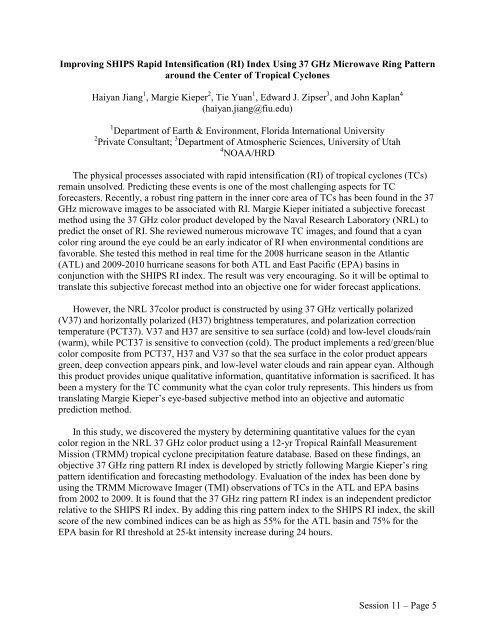65th IHC Booklet/Program (pdf - 4.9MB) - Office of the Federal ...
65th IHC Booklet/Program (pdf - 4.9MB) - Office of the Federal ...
65th IHC Booklet/Program (pdf - 4.9MB) - Office of the Federal ...
Create successful ePaper yourself
Turn your PDF publications into a flip-book with our unique Google optimized e-Paper software.
Improving SHIPS Rapid Intensification (RI) Index Using 37 GHz Microwave Ring Pattern<br />
around <strong>the</strong> Center <strong>of</strong> Tropical Cyclones<br />
Haiyan Jiang 1 , Margie Kieper 2 , Tie Yuan 1 , Edward J. Zipser 3 , and John Kaplan 4<br />
(haiyan.jiang@fiu.edu)<br />
1 Department <strong>of</strong> Earth & Environment, Florida International University<br />
2 Private Consultant; 3 Department <strong>of</strong> Atmospheric Sciences, University <strong>of</strong> Utah<br />
4 NOAA/HRD<br />
The physical processes associated with rapid intensification (RI) <strong>of</strong> tropical cyclones (TCs)<br />
remain unsolved. Predicting <strong>the</strong>se events is one <strong>of</strong> <strong>the</strong> most challenging aspects for TC<br />
forecasters. Recently, a robust ring pattern in <strong>the</strong> inner core area <strong>of</strong> TCs has been found in <strong>the</strong> 37<br />
GHz microwave images to be associated with RI. Margie Kieper initiated a subjective forecast<br />
method using <strong>the</strong> 37 GHz color product developed by <strong>the</strong> Naval Research Laboratory (NRL) to<br />
predict <strong>the</strong> onset <strong>of</strong> RI. She reviewed numerous microwave TC images, and found that a cyan<br />
color ring around <strong>the</strong> eye could be an early indicator <strong>of</strong> RI when environmental conditions are<br />
favorable. She tested this method in real time for <strong>the</strong> 2008 hurricane season in <strong>the</strong> Atlantic<br />
(ATL) and 2009-2010 hurricane seasons for both ATL and East Pacific (EPA) basins in<br />
conjunction with <strong>the</strong> SHIPS RI index. The result was very encouraging. So it will be optimal to<br />
translate this subjective forecast method into an objective one for wider forecast applications.<br />
However, <strong>the</strong> NRL 37color product is constructed by using 37 GHz vertically polarized<br />
(V37) and horizontally polarized (H37) brightness temperatures, and polarization correction<br />
temperature (PCT37). V37 and H37 are sensitive to sea surface (cold) and low-level clouds/rain<br />
(warm), while PCT37 is sensitive to convection (cold). The product implements a red/green/blue<br />
color composite from PCT37, H37 and V37 so that <strong>the</strong> sea surface in <strong>the</strong> color product appears<br />
green, deep convection appears pink, and low-level water clouds and rain appear cyan. Although<br />
this product provides unique qualitative information, quantitative information is sacrificed. It has<br />
been a mystery for <strong>the</strong> TC community what <strong>the</strong> cyan color truly represents. This hinders us from<br />
translating Margie Kieper’s eye-based subjective method into an objective and automatic<br />
prediction method.<br />
In this study, we discovered <strong>the</strong> mystery by determining quantitative values for <strong>the</strong> cyan<br />
color region in <strong>the</strong> NRL 37 GHz color product using a 12-yr Tropical Rainfall Measurement<br />
Mission (TRMM) tropical cyclone precipitation feature database. Based on <strong>the</strong>se findings, an<br />
objective 37 GHz ring pattern RI index is developed by strictly following Margie Kieper’s ring<br />
pattern identification and forecasting methodology. Evaluation <strong>of</strong> <strong>the</strong> index has been done by<br />
using <strong>the</strong> TRMM Microwave Imager (TMI) observations <strong>of</strong> TCs in <strong>the</strong> ATL and EPA basins<br />
from 2002 to 2009. It is found that <strong>the</strong> 37 GHz ring pattern RI index is an independent predictor<br />
relative to <strong>the</strong> SHIPS RI index. By adding this ring pattern index to <strong>the</strong> SHIPS RI index, <strong>the</strong> skill<br />
score <strong>of</strong> <strong>the</strong> new combined indices can be as high as 55% for <strong>the</strong> ATL basin and 75% for <strong>the</strong><br />
EPA basin for RI threshold at 25-kt intensity increase during 24 hours.<br />
Session 11 – Page 5
















